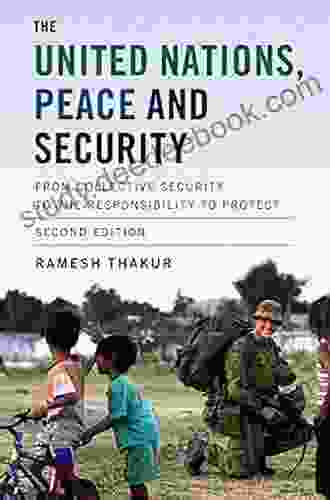From Collective Security to the Responsibility to Protect: A Historical and Conceptual Analysis

The concept of collective security has been a cornerstone of international law since the end of World War I. The League of Nations, established in 1919, was based on the principle that all member states would come to the aid of any member state that was attacked. This principle was further enshrined in the United Nations Charter, which was adopted in 1945. The UN Charter states that all member states "shall refrain from the threat or use of force against the territorial integrity or political independence of any state" and that they "shall give mutual assistance to each other in carrying out the purposes of this Charter."
Despite the lofty goals of the League of Nations and the United Nations, the collective security system has often failed to prevent or stop aggression. In the 1930s, the League of Nations was unable to prevent the rise of fascism and the outbreak of World War II. In the 1990s, the United Nations was unable to stop the Rwandan genocide or the Srebrenica massacre.
5 out of 5
| Language | : | English |
| File size | : | 1555 KB |
| Text-to-Speech | : | Enabled |
| Screen Reader | : | Supported |
| Enhanced typesetting | : | Enabled |
| Word Wise | : | Enabled |
| Print length | : | 428 pages |
In the wake of these failures, the international community began to rethink the concept of collective security. In 2001, the United Nations adopted a new set of norms known as the responsibility to protect (R2P). R2P is based on the idea that every state has a responsibility to protect its own citizens from genocide, war crimes, ethnic cleansing, and crimes against humanity. If a state is unable or unwilling to do so, the international community has a responsibility to intervene to protect civilians.
R2P represents a significant shift in the way the international community understands and responds to mass atrocities. Unlike collective security, which focuses on preventing aggression between states, R2P focuses on protecting civilians from harm within states. This shift reflects a growing recognition that mass atrocities are a threat to international peace and security, and that the international community has a responsibility to act to prevent them.
The R2P norm has been applied in a number of cases, including the 2011 intervention in Libya and the 2013 intervention in the Central African Republic. In both cases, the international community intervened to protect civilians from mass atrocities.
The R2P norm is still evolving, and there are a number of challenges that must be overcome in order to make it fully effective. One challenge is the difficulty of determining when a state is unable or unwilling to protect its own citizens. Another challenge is the risk of intervention being used as a pretext for regime change or other political اهداف.
Despite these challenges, the R2P norm represents a significant step forward in the international community's efforts to prevent and respond to mass atrocities. It is a powerful norm that has the potential to save lives and prevent suffering.
Key Principles of Collective Security and R2P
Collective security and R2P are based on different key principles. Collective security is based on the principle of collective action. All member states of the United Nations are obligated to come to the aid of any member state that is attacked. R2P, on the other hand, is based on the principle of individual responsibility. Every state has a responsibility to protect its own citizens from mass atrocities. If a state is unable or unwilling to do so, the international community has a responsibility to intervene.
Another key difference between collective security and R2P is the scope of their application. Collective security is designed to prevent aggression between states. R2P, on the other hand, is designed to protect civilians from harm within states. This shift reflects a growing recognition that mass atrocities are a threat to international peace and security, and that the international community has a responsibility to act to prevent them.
Mechanisms for Implementing Collective Security and R2P
There are a number of different mechanisms that can be used to implement collective security and R2P. These mechanisms include:
- Diplomacy
- Sanctions
- Peacekeeping
- Intervention
Diplomacy is the first line of defense in both collective security and R2P. Diplomatic efforts can be used to prevent conflicts from escalating and to resolve conflicts peacefully. Sanctions can be used to pressure states to comply with their obligations under international law. Peacekeeping operations can be deployed to help maintain peace and stability in conflict-affected areas. Intervention can be used as a last resort to protect civilians from mass atrocities.
Challenges to Implementing Collective Security and R2P
There are a number of challenges to implementing collective security and R2P. These challenges include:
- The difficulty of determining when a state is unable or unwilling to protect its own citizens
- The risk of intervention being used as a pretext for regime change or other political اهداف
- The lack of resources to implement collective security and R2P
The challenge of determining when a state is unable or unwilling to protect its own citizens is a particularly difficult one. There is no clear-cut definition of what constitutes "inability" or "unwillingness." This makes it difficult to decide when the international community has a responsibility to intervene.
The risk of intervention being used as a pretext for regime change or other political اهداف is also a serious concern. Intervention should only be used as a last resort, and it should always be carried out in accordance with the principles of international law.
The lack of resources to implement collective security and R2P is another challenge. The United Nations and other international organizations need adequate resources to be able to effectively prevent and respond to mass atrocities.
The concept of collective security has been a cornerstone of international law since the end of World War I. However, the collective security system has often failed to prevent or stop aggression. In the 1930s, the League of Nations was unable to prevent the rise of fascism and the outbreak of World War II. In the 1990s, the United Nations was unable to stop the Rwandan genocide or the Srebrenica massacre.
In the wake of these failures, the international community began to rethink the concept of collective security. In 2001, the United Nations adopted a new set of norms known as the responsibility to protect (R2P). R2P is based on the idea that every state has a responsibility to protect its own citizens from genocide, war crimes, ethnic cleansing, and crimes against humanity. If a state is unable or unwilling to do so, the international community has a responsibility to intervene to protect civilians.
R2P represents a significant shift in the way the international community understands and responds to mass atrocities. It is a powerful norm that has the potential to save lives and prevent suffering.
5 out of 5
| Language | : | English |
| File size | : | 1555 KB |
| Text-to-Speech | : | Enabled |
| Screen Reader | : | Supported |
| Enhanced typesetting | : | Enabled |
| Word Wise | : | Enabled |
| Print length | : | 428 pages |
Do you want to contribute by writing guest posts on this blog?
Please contact us and send us a resume of previous articles that you have written.
 Page
Page Text
Text Genre
Genre Reader
Reader Library
Library E-book
E-book Newspaper
Newspaper Paragraph
Paragraph Sentence
Sentence Bookmark
Bookmark Shelf
Shelf Preface
Preface Annotation
Annotation Footnote
Footnote Manuscript
Manuscript Codex
Codex Bestseller
Bestseller Narrative
Narrative Biography
Biography Autobiography
Autobiography Encyclopedia
Encyclopedia Dictionary
Dictionary Thesaurus
Thesaurus Librarian
Librarian Card Catalog
Card Catalog Borrowing
Borrowing Archives
Archives Periodicals
Periodicals Research
Research Lending
Lending Rare Books
Rare Books Literacy
Literacy Study Group
Study Group Thesis
Thesis Dissertation
Dissertation Storytelling
Storytelling Awards
Awards Reading List
Reading List Theory
Theory Textbooks
Textbooks Elizabeth Van Steenwyk
Elizabeth Van Steenwyk Samantha Greene Woodruff
Samantha Greene Woodruff Robert Howling
Robert Howling Benjamin J Hruska
Benjamin J Hruska Jack Kassewitz
Jack Kassewitz Zbigniew Cynkutis
Zbigniew Cynkutis John Nevill
John Nevill Victoria Ong
Victoria Ong Diane Serviss
Diane Serviss David Donachie
David Donachie Oliver J Rich
Oliver J Rich Crystalina Evert
Crystalina Evert William Cope Moyers
William Cope Moyers Brandy Woods Smith
Brandy Woods Smith Wahida Clark
Wahida Clark Richard Carman
Richard Carman Amber Richards
Amber Richards Bernard Brunstein
Bernard Brunstein Delia Ephron
Delia Ephron Catherine Coulter
Catherine Coulter
Light bulbAdvertise smarter! Our strategic ad space ensures maximum exposure. Reserve your spot today!
 Denzel HayesFollow ·14.4k
Denzel HayesFollow ·14.4k Junot DíazFollow ·6.1k
Junot DíazFollow ·6.1k Stanley BellFollow ·14k
Stanley BellFollow ·14k Braden WardFollow ·3.1k
Braden WardFollow ·3.1k T.S. EliotFollow ·16.4k
T.S. EliotFollow ·16.4k H.G. WellsFollow ·7.9k
H.G. WellsFollow ·7.9k Patrick HayesFollow ·16.3k
Patrick HayesFollow ·16.3k Craig CarterFollow ·16.2k
Craig CarterFollow ·16.2k

 Dominic Simmons
Dominic SimmonsIcky Island: An Unforgettable Adventure for Kids!
Introducing Icky Island: A Delightful One...

 Carlos Fuentes
Carlos FuentesThe Midnight Breed: Embracing the Shadows and Unlocking a...
Welcome to the captivating world of...

 Ike Bell
Ike BellTwelve Steps Toward Political Revelation: A Path to...
Politics, often perceived as a complex and...

 Cameron Reed
Cameron ReedTravels in Arizona Goldfield: Unraveling the Threads of...
Nestled amidst the rugged...

 John Grisham
John GrishamFlashpoints of Cinema History and Queer Politics:...
The relationship between cinema history and...
5 out of 5
| Language | : | English |
| File size | : | 1555 KB |
| Text-to-Speech | : | Enabled |
| Screen Reader | : | Supported |
| Enhanced typesetting | : | Enabled |
| Word Wise | : | Enabled |
| Print length | : | 428 pages |














